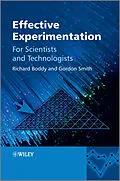Effective Experimentation is a practical book on how to
design and analyse experiments. Each of the methods are introduced
and illustrated through real world scenario drawn from industry or
research. Formulae are kept to a minimum to enable the reader to
concentrate on how to apply and understand the different methods
presented.
The book has been developed from courses run by Statistics
for Industry Limited during which time more than 10,000
scientists and technologists have gained the knowledge and
confidence to plan experiments successfully and to analyse their
data. Each chapter starts with an example of a design obtained from
the authors' experience. Statistical methods for analysing
data are introduced, followed, where appropriate, by a discussion
of the assumptions of the method and effectiveness and limitations
of the design.
The examples have been chosen from many industries including
chemicals, oils, building materials, textiles, food, drink,
lighting, water, pharmaceuticals, electronics, paint, toiletries
and petfoods.
This book is a valuable resource for researchers and industrial
statisticians involved in designing experiments.
Postgraduates studying statistics, engineering and mathematics will
also find this book of interest.
Autorentext
Richard Boddy, Director of S4i Limited, Co-founder of
Statistics for Industry and Director for 30 years and has lectured
on more than 300 courses to scientists and technologists from
industry.
Gordon Laird Smith, Consultant Statistician, Director of
Statistics for Industry, developing and presenting training courses
to scientists and technologists of all disciplines at all
levels.
Zusammenfassung
Effective Experimentation is a practical book on how to design and analyse experiments. Each of the methods are introduced and illustrated through real world scenario drawn from industry or research. Formulae are kept to a minimum to enable the reader to concentrate on how to apply and understand the different methods presented.
The book has been developed from courses run by Statistics for Industry Limited during which time more than 10,000 scientists and technologists have gained the knowledge and confidence to plan experiments successfully and to analyse their data. Each chapter starts with an example of a design obtained from the authors' experience. Statistical methods for analysing data are introduced, followed, where appropriate, by a discussion of the assumptions of the method and effectiveness and limitations of the design.
The examples have been chosen from many industries including chemicals, oils, building materials, textiles, food, drink, lighting, water, pharmaceuticals, electronics, paint, toiletries and petfoods.
This book is a valuable resource for researchers and industrial statisticians involved in designing experiments. Postgraduates studying statistics, engineering and mathematics will also find this book of interest.
Inhalt
Preface.
1 Why Bother to Design an Experiment?
1.1 Indroduction.
1.2 Examples and Benefits.
1.2.1 Develop a Better Product.
1.2.2 Which Antiperspirant is Best?
1.2.3 A Complex Project.
1.3 Good Design and Good Analysis.
2 A Change for the Better Significance Testing.
2.1 Introduction.
2.2 Towards a Darker Stout.
2.3 Summary Statistics.
2.4 The Normal Distribution.
2.5 How Accurate is My Mean?
2.6 Is the New Additive an Improvement?
2.7 How Many Trials are Needed for an Experiment?
2.8 Were the Aims of the Investigation Achieved?
2.9 Problems.
3 Improving Effectiveness Using a Paired Design.
3.1 Introduction.
3.2 An Example: Who Wears the Trousers?
3.3 How Do We Rate the Wear?
3.4 How Often Do You Carry Out an Assessment?
3.5 Choosing the Participants.
3.6 Controlling the Participants.
3.7 The Paired Design.
3.8 Was the Experiment Successful?
3.9 Problems.
4 A Simple but Effective Design for Two Variables.
4.1 Introduction.
4.2 An Investigation.
4.3 Limitations of a One-Variable-at-a-Time Experiment.
4.4 A Factorial Experiment.
4.5 Confidence Intervals for Effect Estimates.
4.6 What Conditions Should be Recommended?
4.7 Were the Aims of the Investigation Achieved?
4.8 Problems.
5 Investigating 3 and 4 Variables in an Experiment.
5.1 Introduction.
5.2 An Experiment with Three Variables.
5.3 The Design Matrix Method.
5.4 Computation of Predicted Values.
5.5 Computation of Confidence Interval.
5.6 95% Confidence Interval for an Effect.
5.7 95% Confidence Interval for a Predicted Value.
5.8 Sequencing of the Trials.
5.9 Were the Aims of the Experiment Achieved?
5.10 A Four-Variable Experiment.
5.11 Half-Normal Plots.
5.12 Were the Aims of the Experiment Achieved?
5.13 Problems.
6 More for Even Less: Using a Fraction of a Full Design.
6.1 Introduction.
6.2 Obtaining Half-Fractional Designs.
6.2.1 With Defining Contrast ABC.
6.2.2 With Defining Contrast AC.
6.3 Design of ½(24) Experiment.
6.4 Analysing a Fractional Experiment.
6.5 Summary 59
6.6 Did Wheelwright Achieve the Aims of His Experiment?
6.7 When and Where to Choose a Fractional Design.
6.7.1 Three Variables.
6.7.2 Four Variables.
6.7.3 Five Variables or More.
6.8 Problems.
7 Saturated Designs.
7.1 Introduction.
7.2 Towards a Better Oil?
7.3 The Experiment.
7.4 An Alternative Procedure for Estimating the Residual SD.
7.5 Did Doug Achieve the Aims of His Experiment?
7.6 How Rugged is My Method?
7.7 Analysis of the Design.
7.8 Conclusions from the Experiment.
7.9 Did Serena Achieve Her Aims?
7.10 Which Order Should I Use for the Trials?
7.11 How to Obtain the Designs.
7.12 Other Uses of Saturated Designs.
7.13 Problems.
8 Regression Analysis.
8.1 Introduction.
8.2 Example: Keeping Quality of Sprouts.
8.3 How Good a Fit Has the Line to the Data?
8.4 Residuals.
8.5 Percentage Fit.
8.6 Correlation Coefficient.
8.7 Percentage Fit An Easier Method.
8.8 Is There a Significant Relationship between the Variables?
8.9 Confidence Intervals for the Regression Statistics.
8.10 Assumptions.
8.11 Problem.
9 Multiple Regression: The First Essentials.
9.1 Introduction.
9.2 A...
